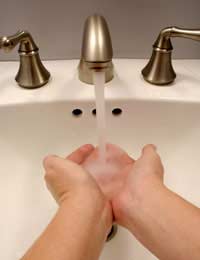Increase Water Efficiency in the Workplace

As the demand for water in our daily lives increases, and supplies become increasingly strained, the need to conserve and carefully manage our office water supplies has become particularly acute.
Install A Water Meter
Fortunately it is relatively easy to significantly reduce the consumption of water in the workplace without lowering levels of hygiene, safety or even necessity.If your office is not fitted with one already, then your first effort in increasing water efficiency in the workplace should be to install a water meter. This will allow you to monitor how much water is consumed and also help assess the success of the water saving measures you implement.
There are a variety of types available. It is advisable to ask your current supplier for more information and advice on selecting the right one for you.
Staff Water Saving Solutions
It is advisable to begin your water efficiency scheme by first educating staff about the importance of water conservation and their role in its preservation.It has estimated that each and every UK office worker uses an incredible 35 litres of water every day. By implementing a simple policy of good water practice in the office this amount could be significantly reduced, and uncover savings of around 30% on water and effluent bills.
By means of talks, workshops, email announcements or a poster and sticker campaign, staff can be reminded of the importance of adopting such simple but effective water practice as:
- Only fill up kettles with as much water as you need rather than to the brim.
- Use a plugged sink and bowl of water when washing cups and plates, instead of washing them under a running tap.
- Only switch on the dishwater when it is full.
- Make sure taps are turned off properly.
To help motivate staff, water conservation could be linked to staff performance reviews and visual aids such as wall charts and graphs can be used to highlight goals and water saving successes.
It is also a good idea to encourage staff to suggest their own water saving ideas.Leakage Solutions
The everyday actions of employees are of course not responsible for all water wastage in the workplace, litres could be secretly draining away through leaks and dripping taps. A dripping tap, for instance, could be wasting as much as 90 litres a week.It is important to check all areas where water is used within the office building, such as cisterns, pipes, overflows and, of course, taps. Staff should be encouraged to report any leaks they might discover, and these should be repaired promptly.
Nevertheless, leakages are more likely to occur in piping beneath or adjacent to the building and so may require expert assistance from the water supplier.
With a water meter installed you can check for any leakage by turning off the water and taking two meter readings at about a ten minute interval. If the results are different then you could well have a leak. Alternatively there is the option of fitting a specialised leak detection system.
Saving Toilet Water
Office bathrooms account for a large percentage of its water use. Of that 35 litres used by each employee everyday, 86% is the result of flushing toilets. As employees can’t be encouraged to use the toilet less, the answer is to switch to a more efficient low water unit.This needn’t be a costly exercise - easy-to-fit WC cistern displacement devices – such as a ‘bog hog’ or HIPPO - are a cheap but effective option. These are not appropriate for all toilets so it’s important to first consult your supplier, and also to make sure they are installed correctly.
Nevertheless, it is worth considering updating toilets to ultra-efficient models, which are specially designed to operate effectively at low flush volumes. This would require a much larger investment but despite their advanced design, such toilets do at least cost as much as the more traditional toilet.
Where appropriate, urinals are more water efficient that toilets, particularly those with sensor or air flushing controls or the new waterless design, which can potentially save thousands of litres of water every year.
Water Minimising Office Supplies
There is a variety of other water minimising devices now available and worth investigating. These include:- Percussion taps – these turn off after a set period.
- Spray inserts in well used taps – these reduce the amount of water used without sacrificing water efficiency.
- Water and energy efficient washing machines and dishwashers – look out for ‘A’ rated products.
- Extended trigger handles for taps – these are fitted to tap points and are ideal for kitchens as they reduce water use during food preparation and cleaning.


Re: How to Control the Problem Of E-Waste
Amol - Your Question:I search this website on opera mini. Because I create a seminar on environment about e-waste. I…
Re: How to Control the Problem Of E-Waste
I search this website on opera mini . Because i create a seminar on environment about e-waste. i tell that website…